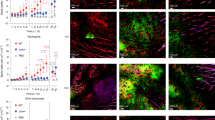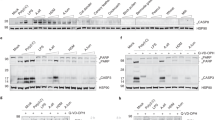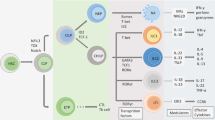Abstract
Antimicrobial proteins constitute a phylogenetically ancient form of innate immunity that provides host defence at skin and mucosal surfaces. Although some components of this system are constitutively expressed, new evidence reviewed in this Progress article shows that the production of certain antimicrobial proteins by epithelial cells can also be regulated by cytokines of the innate and adaptive immune systems. In particular, the effector cytokines interleukin-17 and interleukin-22, which are produced by the T-helper-17-cell subset, are emerging as crucial regulators of antimicrobial-peptide production in the gut and the lungs. This suggests that this T-cell lineage and its cytokines have important roles in skin and mucosal immunity.
This is a preview of subscription content, access via your institution
Access options
Subscribe to this journal
Receive 12 print issues and online access
$209.00 per year
only $17.42 per issue
Buy this article
- Purchase on Springer Link
- Instant access to full article PDF
Prices may be subject to local taxes which are calculated during checkout


Similar content being viewed by others
References
Zelensky, A. N. & Gready, J. E. The C-type lectin-like domain superfamily. FEBS J. 272, 6179–6217 (2005).
Soruri, A., Grigat, J., Forssmann, U., Riggert, J. & Zwirner, J. β-defensins chemoattract macrophages and mast cells but not lymphocytes and dendritic cells: CCR6 is not involved. Eur. J. Immunol. 37, 2474–2486 (2007).
Kuhara, T., Yamauchi, K., Tamura, Y. & Okamura, H. Oral administration of lactoferrin increases NK cell activity in mice via increased production of IL-18 and type I IFN in the small intestine. J. Interferon Cytokine Res. 26, 489–499 (2006).
Yu, J. et al. Host defense peptide LL-37, in synergy with inflammatory mediator IL-1β, augments immune responses by multiple pathways. J. Immunol. 179, 7684–7691 (2007).
Zheng, Y. et al. Cathelicidin LL-37 induces the generation of reactive oxygen species and release of human α-defensins from neutrophils. Br. J. Dermatol. 157, 1124–1131 (2007).
Shi, J. et al. A novel role for defensins in intestinal homeostasis: regulation of IL-1β secretion. J. Immunol. 179, 1245–1253 (2007).
Singh, P. K. et al. Production of β-defensins by human airway epithelia. Proc. Natl Acad. Sci. USA 95, 14961–14966 (1998).
Cowland, J. B., Sorensen, O. E., Sehested, M. & Borregaard, N. Neutrophil gelatinase-associated lipocalin is up-regulated in human epithelial cells by IL-1β, but not by TNF-α. J. Immunol. 171, 6630–6639 (2003).
Bando, M. et al. Interleukin-1α regulates antimicrobial peptide expression in human keratinocytes. Immunol. Cell Biol. 85, 532–537 (2007).
Yano, S., Banno, T., Walsh, R. & Blumenberg, M. Transcriptional responses of human epidermal keratinocytes to cytokine interleukin-1. J. Cell. Physiol. 214, 1–13 (2008).
Weijer, S. et al. Interleukin-18 facilitates the early antimicrobial host response to Escherichia coli peritonitis. Infect. Immun. 71, 5488–5497 (2003).
Wiersinga, W. J. et al. Endogenous interleukin-18 improves the early antimicrobial host response in severe melioidosis. Infect. Immun. 75, 3739–3746 (2007).
McDonald, V. et al. A potential role for interleukin-18 in inhibition of the development of Cryptosporidium parvum. Clin. Exp. Immunol. 145, 555–562 (2006).
Uehara, A. et al. Chemically synthesized pathogen-associated molecular patterns increase the expression of peptidoglycan recognition proteins via toll-like receptors, NOD1 and NOD2 in human oral epithelial cells. Cell. Microbiol. 7, 675–686 (2005).
Wang, H., Gupta, D., Li, X. & Dziarski, R. Peptidoglycan recognition protein 2 (N-acetylmuramoyl-L-ala amidase) is induced in keratinocytes by bacteria through the p38 kinase pathway. Infect. Immun. 73, 7216–7225 (2005).
Happel, K. I. et al. Cutting Edge: roles of toll-like receptor 4 and IL-23 in IL-17 expression in response to Klebsiella pneumoniae infection. J. Immunol. 170, 4432–4436 (2003).
Huang, W., Na, L., Fidel, P. L. & Schwarzenberger, P. Requirement of interleukin-17A for systemic anti-Candida albicans host defense in mice. J. Infect. Dis. 190, 624–631 (2004).
Chen, Z., Tato, C. M., Muul, L., Laurence, A. & O'Shea, J. J. Distinct regulation of interleukin-17 in human T helper lymphocytes. Arthritis Rheum. 56, 2936–2946 (2007).
Wilson, N. J. et al. Development, cytokine profile and function of human interleukin 17-producing helper T cells. Nature Immunol. 8, 950–957 (2007).
Schwarzenberger, P. et al. Requirement of endogenous stem cell factor and granulocyte-colony-stimulating factor for IL-17-mediated granulopoiesis. J. Immunol. 164, 4783–4789 (2000).
McAllister, F. et al. Role of IL-17A, IL-17F, and the IL-17 receptor in regulating growth-related oncogene-α and granulocyte colony-stimulating factor in bronchial epithelium: implications for airway inflammation in cystic fibrosis. J. Immunol. 175, 404–412 (2005).
Kao, C.-Y. et al. IL-17 markedly up-regulates β-defensin-2 expression in human airway epithelium via JAK and NF-κB signaling pathways. J. Immunol. 173, 3482–3491 (2004).
Huang, F. et al. Requirement for both JAK-mediated PI3K signaling and ACT1/TRAF6/TAK1-dependent NF-κB activation by IL-17A in enhancing cytokine expression in human airway epithelial cells. J. Immunol. 179, 6504–6513 (2007).
Wolk, K. et al. IL-22 increases the innate immunity of tissues. Immunity 21, 241–254 (2004).
Liang, S. C. et al. Interleukin (IL)-22 and IL-17 are coexpressed by Th17 cells and cooperatively enhance expression of antimicrobial peptides. J. Exp. Med. 203, 2271–2279 (2006).
Aujla, S. J. et al. IL-22 mediates mucosal host defense against Gram-negative bacterial pneumonia. Nature Med. 14, 275–281 (2008).
Boniface, K. et al. IL-22 inhibits epidermal differentiation and induces proinflammatory gene expression and migration of human keratinocytes. J. Immunol. 174, 3695–3702 (2005).
Wolk, K. et al. IL-22 regulates the expression of genes responsible for antimicrobial defense, cellular differentiation, and mobility in keratinocytes: a potential role in psoriasis. Eur. J. Immunol. 36, 1309–1323 (2006).
Zheng, Y. et al. Interleukin-22 mediates early host defense against attaching and effacing bacterial pathogens. Nature Med. 14, 282–289 (2008).
Cash, H. L., Whitham, C. V., Behrendt, C. L. & Hooper, L. V. Symbiotic bacteria direct expression of an intestinal bactericidal lectin. Science 313, 1126–1130 (2006).
Brandl, K., Plitas, G., Schnabl, B., DeMatteo, R. P. & Pamer, I. E. MyD88-mediated signals induce the bactericidal lectin RegIIIγ and protect mice against intestinal Listeria monocytogenes infection. J. Exp. Med. 204, 1891–1900 (2007).
Wolk, K. et al. IL-22 induces lipopolysaccharide-binding protein in hepatocytes: a potential systemic role of IL-22 in Crohn's disease. J. Immunol. 178, 5973–5981 (2007).
Ong, P. Y. et al. Endogenous antimicrobial peptides and skin infections in atopic dermatitis. N. Engl. J. Med. 347, 1151–1160 (2002).
Sa, S. M. et al. The effects of IL-20 subfamily cytokines on reconstituted human epidermis suggest potential roles in cutaneous innate defense and pathogenic adaptive immunity in psoriasis. J. Immunol. 178, 2229–2240 (2007).
Zheng, Y. et al. Interleukin-22, a TH17 cytokine, mediates IL-23-induced dermal inflammation and acanthosis. Nature 445, 648–651 (2007).
Ma, C. S. et al. Deficiency of Th17 cells in hyper IgE syndrome due to mutations in STAT3. J. Exp. Med. 205, 1551–1557 (2008).
Nomura, I. et al. Cytokine milieu of atopic dermatitis, as compared to psoriasis, skin prevents induction of innate immune response genes. J. Immunol. 171, 3262–3269 (2003).
Albanesi, C. et al. IL-4 and IL-13 negatively regulate TNF-α- and IFN-γ-induced β-defensin expression through STAT-6, suppressor of cytokine signaling (SOCS)-1, and SOCS-3. J. Immunol. 179, 984–992 (2007).
Pedemonte, N. et al. Thiocyanate transport in resting and IL-4-stimulated human bronchial epithelial cells: role of pendrin and anion channels. J. Immunol. 178, 5144–5153 (2007).
Lande, R. et al. Plasmacytoid dendritic cells sense self-DNA coupled with antimicrobial peptide. Nature 449, 564–569 (2007).
Acosta-Rodriguez, E. V. et al. Surface phenotype and antigenic specificity of human interleukin 17-producing T helper memory cells. Nature Immunol. 8, 639–646 (2007).
Schneider, J. J., Unholzer, A., Schaller, M., Schäfer-Korting, M. & Korting, H. C. Human defensins. J. Mol. Med. 83, 587–595 (2005).
Lehrer, R. I. Primate defensins. Nature Rev. Microbiol. 2, 727–738 (2004).
Zanetti, M. The role of cathelicidins in the innate host defenses of mammals. Curr. Issues Mol. Biol. 7, 179–196 (2005).
Glaser, R. et al. Antimicrobial psoriasin (S100A7) protects human skin from Escherichia coli infection. Nature Immunol. 6, 157–164 (2005).
Lee, K. C. & Eckert, R. L. S100A7 (psoriasin) — mechanism of antibacterial action in wounds. J. Invest. Dermatol. 127, 945–957 (2007).
Buchau, A. S. et al. S100A15, an antimicrobial protein of the skin: regulation by E. coli through Toll-like receptor 4. J. Invest. Dermatol. 127, 2596–2604 (2007).
Gottsch, J. D., Eisinger, S. W., Liu, S. H. & Scott, A. L. Calgranulin C has filariacidal and filariastatic activity. Infect. Immun. 67, 6631–6636 (1999).
Baranger, K., Zani, M. L., Chandenier, J., Dallet-Choisy, S. & Moreau, T. The antibacterial and antifungal properties of trappin-2 (pre-elafin) do not depend on its protease inhibitory function. FEBS J. 275, 2008–2020 (2008).
Bellemare, A., Vernoux, N., Morisset, D. & Bourbonnais, Y. Human pre-elafin inhibits a Pseudomonas aeruginosa-secreted peptidase and prevents its proliferation in complex media. Antimicrob. Agents Chemother. 52, 483–490 (2008).
Williams, S. E., Brown, T. I., Roghanian, A. & Sallenave, J. M. SLPI and elafin: one glove, many fingers. Clin. Sci. (Lond.) 110, 21–35 (2006).
Dziarski, R. & Gupta, D. The peptidoglycan recognition proteins (PGRPs). Genome Biol. 7, 232 (2006).
Legrand, D., Elass, E., Pierce, A. & Mazurier, J. Lactoferrin and host defence: an overview of its immuno-modulating and anti-inflammatory properties. Biometals 17, 225–229 (2004).
Kemna, E. H. J. M., Tjalsma, H., Willems, H. L. & Swinkels, D. W. Hepcidin: from discovery to differential diagnosis. Haematologica 93, 90–97 (2008).
Borregaard, N. & Cowland, J. Neutrophil gelatinase-associated lipocalin, a siderophore-binding eukaryotic protein. Biometals 19, 211–215 (2006).
Esche, C., Stellato, C. & Beck, L. A. Chemokines: key players in innate and adaptive immunity. J. Invest. Dermatol. 125, 615–628 (2005).
Acknowledgements
This work was supported by grants from the National Institutes of Health (NIH), USA, to J.K.K (P50HL084932 and R01HL079142) and P.B.M. (P50HL61234), grants from the Roy J. Carver Charitable Trust to P.B.M. and a grant from the National Heart, Lung and Blood Institute (NHLBI) to Y.R.C. (K08HL089189).
Author information
Authors and Affiliations
Corresponding author
Related links
Related links
DATABASES
OMIM
FURTHER INFORMATION
Rights and permissions
About this article
Cite this article
Kolls, J., McCray, P. & Chan, Y. Cytokine-mediated regulation of antimicrobial proteins. Nat Rev Immunol 8, 829–835 (2008). https://doi.org/10.1038/nri2433
Issue Date:
DOI: https://doi.org/10.1038/nri2433
This article is cited by
-
Insulin alleviates murine colitis through microbiome alterations and bile acid metabolism
Journal of Translational Medicine (2023)
-
Gamma-delta T cells modulate the microbiota and fecal micro-RNAs to maintain mucosal tolerance
Microbiome (2023)
-
The translational revolution in atopic dermatitis: the paradigm shift from pathogenesis to treatment
Cellular & Molecular Immunology (2023)
-
Diabetes downregulates the antimicrobial peptide psoriasin and increases E. coli burden in the urinary bladder
Nature Communications (2022)
-
Cytoskeletal Organization and Cell Polarity in the Pathogenesis of Crohn’s Disease
Clinical Reviews in Allergy & Immunology (2021)



